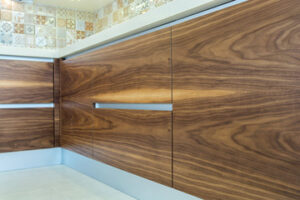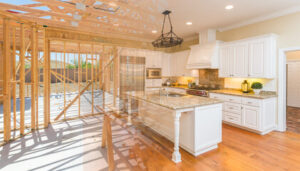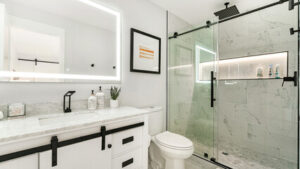Cabinet Refacing Revamps Your Kitchen Without Spending a Fortune
Cabinet Refacing Sacramento CA is typically faster and more cost-effective than replacing cabinets entirely. It is also less disruptive, allowing you to continue using your kitchen and bathroom throughout the project.

Wood veneers resemble solid wood and come in a wide variety of colors and finishes. They are durable but can swell when exposed to moisture.
Cabinet Refacing is a great way to revamp your kitchen without spending a fortune. It is an eco-friendly option that can be completed in less time than full cabinet replacement, resulting in significant savings in labor and materials costs. Additionally, it can be implemented in stages, allowing you to update your kitchen gradually. Before you hire a remodeling company to do the job, it’s important to have a clear understanding of your budget. This will allow the team to provide suggestions that can be implemented within your desired budget.
Choosing the right design options for your cabinets can be an exciting part of the process. There are a variety of choices available, including door styles, knobs and pull hardware, and finish colors. You can look for inspiration from home decor magazines, online design galleries, and social media platforms. By taking into account the overall aesthetic of your home and your kitchen, you can create a style that is cohesive throughout the room.
Another benefit of cabinet refacing is that it can increase your home’s value. By adding new doors and drawer fronts, you can enhance the appearance of your kitchen and add a fresh, stylish aesthetic that will appeal to potential buyers. Cabinet refacing is also more cost-effective than a complete kitchen renovation, and it can be performed without requiring the services of multiple contractors or the disruption of water and electrical lines.
Maintaining the beauty of your newly refaced cabinets is simple. Simply wiping them down with a mild cleaner can help to keep them looking like new. In addition, the use of preventive measures like coasters and placemats can protect against damage from heat and spills. The refacing material you choose will determine how much maintenance is required. For example, solid wood requires gentle cleaning and regular polishing, while materials like rigid thermofoil require minimal care.
As a sustainable alternative to full cabinet replacement, cabinet refacing can save up to 60% of the material and labor costs associated with the installation of new cabinets. In addition, refacing uses the existing cabinet framework, eliminating the need for additional material production and transportation. This significantly reduces the demand for energy, which is typically sourced from fossil fuels.
Time-Saving
Cabinet refacing is less time-consuming than a full renovation, and the process allows homeowners to maintain kitchen functionality while getting their project done. Unlike full kitchen remodels, which can last weeks or even months with kitchens out of commission, cabinet refacing only requires a few days to complete and minimizes disruption to household routines. Refacing also generates significantly less waste than a traditional kitchen remodel, which is good for the environment and your budget.
Using the existing structure of your cabinets, cabinet refacing adds a new look and feel to your space by changing the doors and drawer fronts. We offer a wide range of materials, colors, and styles to match your personal preferences, and the finish can be durable enough to withstand everyday use and wear. This means your refaced cabinets will last for years to come, enhancing the aesthetic of your kitchen and boosting your home’s resale value.
While refacing is cheaper than replacing your entire cabinetry, it’s important to keep in mind that it may not be as functional or high-quality as a total replacement. For instance, if your cabinet boxes are structurally unsound or made of low-quality materials, refacing them will not solve the problem and could mask problems that might need to be addressed in the future, resulting in increased costs down the line.
In addition, refacing offers limited customization options compared to a complete replacement. This can be an issue if you’re seeking a unique or specific style. Similarly, because the material used for the cabinet boxes is typically wood veneer, it can be more susceptible to moisture and damage over time.
Another disadvantage of refacing is that it will not increase your home’s resale or living value as much as a new kitchen. Nevertheless, it’s an excellent choice for Boone homeowners who want to upgrade their kitchen without spending a fortune on a complete overhaul. With a little bit of work and the right team, you can get your dream kitchen for a fraction of the cost. Contact Let’s Face It to learn more about how our refacing services can transform your kitchen.
Versatile
Cabinet refacing is an excellent choice for homeowners who want to update their kitchen’s aesthetic without committing to a full renovation. It offers an array of design options to complement any style preference, ranging from contemporary to traditional aesthetics. The refacing process uses the existing cabinet structure and reduces waste, which makes it an environmentally friendly option. Moreover, it is an excellent alternative to complete replacement that can significantly increase a home’s resale value.
The refacing process allows for a wide variety of material and color choices to create the desired aesthetic, including solid wood and laminate finishes. Laminate is an affordable and durable option, resistant to moisture and stains. It is available in a variety of colors, from classic shades to bold statement hues. Wood veneers, on the other hand, offer a more natural, rustic feel. They can be complemented by wood grain pattern or stain to match the overall design theme of the kitchen.
Choosing the right materials for your cabinet refacing project is an important step in your remodeling journey. It is recommended to work with a professional company that offers high-quality products and services. This way, you can be confident that the results will be flawless and long-lasting. Moreover, the company should provide an extensive range of design and finish options to ensure that you can find the perfect fit for your home.
Aside from the design options, refacing is also an effective alternative for homeowners who want to repair or replace their existing hardware and drawer fronts. This can make the entire space more ergonomic and functional. Refacing is not, however, ideal for those who are looking to reconfigure their cabinet layout or address structural issues.
Whether you want to transform your kitchen with walnut wood cabinet refacing or create a modern industrial vibe with stainless steel cabinets, you can rely on the experts at NextDAY Cabinets to help you get the look and functionality you want. The team’s expertise and attention to detail result in beautiful, stress-free projects that exceed client expectations. You can view the different styles and finishes in person at the Chantilly showroom, ensuring that your new kitchen will be exactly what you’ve imagined.
Environmentally Friendly
Cabinet refacing is an eco-friendly choice that’s more environmentally conscious than fully replacing your existing cabinetry. Refacing uses the existing cabinet boxes and hardware, which reduces construction waste and minimizes energy use. The manufacture of new cabinets from raw materials requires a large amount of energy, which is not only costly but also generates greenhouse gas emissions. This process also takes away from our natural resources. By using the materials and hardware that you already have, cabinet refacing is more environmentally friendly than replacing your entire kitchen.
Refacing is also more environmentally friendly than full replacement because it eliminates the need for new cabinet box materials that are typically fabricated from plywood and hardwoods. These materials require significant amounts of raw material that is sourced from the environment. By eliminating this requirement, refacing saves the planet’s natural resources and conserves our ecosystems.
Replacing your existing cabinets can leave your home with a generic look, but refacing your cabinets gives you the flexibility to customize the style and color of your new doors, drawer fronts, and molding. In addition, you have the option of choosing from a wide range of sustainable materials that are better for the environment than traditional woods or laminates.
Some of these green options include reclaimed wood and thermofoil, which is a durable, easy-to-clean material made from recyclable PVC with a low-waste manufacturing process. By utilizing these options, you can achieve a sleek and modern look that is eco-conscious. You can also make your remodeling project even greener by choosing zero-VOC paints and finishes that are safer for your family, the planet, and your health.
Many of the big-box cabinetry sold at home improvement stores is fabricated from MDF that contains high levels of formaldehyde. When you choose to reface your cabinetry with wood from a reclaimed source, it eliminates the need for more new wood and keeps this hazardous chemical off of our earth. Additionally, if you choose to reface your cabinetry using a composite material, you can reduce your environmental impact even further by opting for a product that is manufactured with recycled content and has a low-VOC finish.








